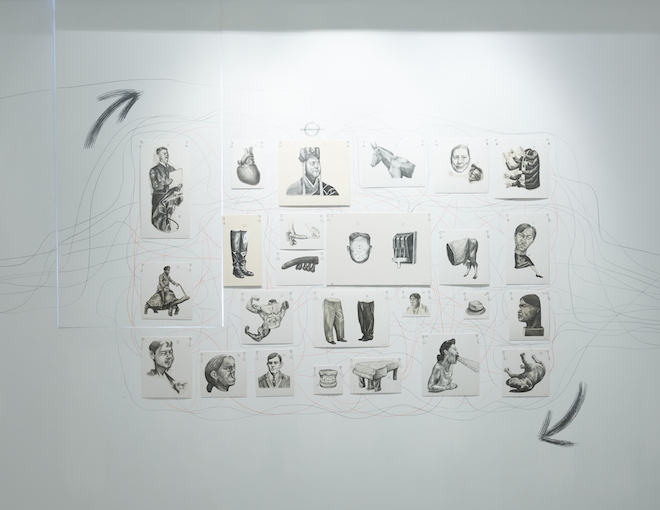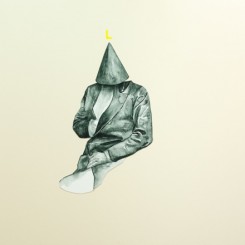Yang Dongxue (b.1984) is one of a growing number of Chinese artists, including Wu Junyong, Sun Xun and Qiu Anxiong, who tell biting historical, social and political parables through wry and satirical drawing, caricature and graphic design. On the occasion of his first solo show, at Beijing’s Pékin Fine Arts, randian 燃点 interviewed Yang about his exhibition.
Chris Moore: What is your new exhibition at Pékin Fine Arts in Hong Kong about?
Yang Dongxue: So sorry, but I need to correct that title. I made a mistake. The full title of this exhibition should be “Semi-Functional Lost Fragments/‘Regarding the Silent Majority’”.
This show is about the realities we cannot or do not want to change; it’s about the kind of “dependency” people develop for a terrible and unjust reality. Even more: a structural deficiency and disorder. I mean, there would be across-the-board unemployment for law enforcement personnel if there weren’t any criminals in the world. That’s why so many artists thrive on chaos.
CM: Your current show bears the same title as one of Wang Xiaobo’s books. Could you elaborate on your choice of title?
YDX: There’s also a movie by the same name, by the way. The name was an intuitive choice rather than a carefully considered selection. These works express an attitude towards an immutable reality; it’s an attitude the majority of people have. If you pay careful attention to my work, you’ll notice they all involve the relationship between consciousness and materiality. Sex or politics aren’t important to me. They’re what I thought of within a specific time period, effective only under specific times and situations. My labor is what’s important and what I emphasize. An artist’s only value lies in his labor and product. Everyone has to live with politics, so there’s no point in overthinking it. I can’t solve those issues; at best, they’re fodder for my work. I don’t like setting parameters for imagination, because I’d rather stitch together a patchwork of imagination through my audience. I don’t want my work to stay put; I want it to open doors
CM: Why do you use watercolor?
YDX: The gallery commissioned them. They’re easy to transport.

Yang Dongxue, “Regarding The Silent Majority”, Exhibition view, courtesy of Pékin Fine Arts, photographed by Kwan Sheung Chi
杨冬雪,《关于沉默的大多数》,展览现场,图片由北京艺门提供,Kwan Sheung Chi拍摄

Yang Dongxue, “Regarding The Silent Majority”, Exhibition view, courtesy of Pékin Fine Arts, photographed by Kwan Sheung Chi
杨冬雪,《关于沉默的大多数》,展览现场,图片由北京艺门提供,Kwan Sheung Chi拍摄
CM: Some of your works involve abandoned equipment used in political rallies or sporting events, such as the movable grandstand in “Semi-Functional Lost Fragments B” (2013). Could you go into detail about your perspective on these works?
YDX: “Semi-Functional Lost Fragments” refers to the way how objects are consciously manipulated and processed. After objects are “processed”, the original ideas along with the forms outputted die inside this “creative process”. I’m fascinated with using certain moves to present the idea that I have never existed, or have existed unconsciously. More accurately, every single work I’ve done since 2005 can be prefaced with the words “semi-functional lost fragments”. The moves I was talking about can only take effect under certain temporal, contextual, and spatial conditions. Without these constraints, I’m just another face in the moving crowd—merely a relatively happy slave.
As for the different images denoted by the letters B, A, or F in the series are just visual cues I use to access a creative paradigm—they’re a means to a beginning or an end.
CM: The letters following each work in your “Semi-Functional Lost Fragments” series remind me of cards used in criminal investigations to classify evidence or cards used to help children learn the alphabet. Are you combining policing and pedagogy?
YDX: My “Semi-Functional Lost Fragments” are playing tricks on you with these letters.
CM: Who is the officer riding a tortoise in [insert title]?
YDX: I don’t know. Whoever you consider him to be, though, I will believe that’s what you considered.
CM: There’s quite a bit of sexual content on show—the questionably phallic cone stuck though a globe is one of the more innocuous examples. Are you drawing parallels between sex, politics, and freedom of expression, personally as well as generally?
YDX: It’s not as complicated as you’re making it. Basically, I chose my materials intuitively, and followed my instincts in my construction of images. Then I hung the finished products on the wall.
CM: Speaking of sex and politics, are you influenced by artists like Wu Junyong and your contemporary Sun Xun?
YDX: I haven’t actually focused on these issues. I’m not interested in just politics or just sex. Those topics are excessively broad; so broad they’re not even issues anymore. They’re also extremely complicated. Turning these problems into data is too much work. At most, I can only create a graphic story based on material and scenes relating to sex and politics. I don’t know if artists like Wu Junyong and Sun Xun have affected me. I guess I’ve learned from them. I take away things I lack from their work because they’re artists worth learning from.


